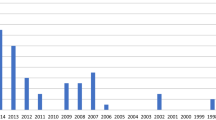Abstract
Scientific co-authorship of African researchers has become a fashionable topic in the recent scientometric literature. Researchers are investigating the effects, modes, dynamics and motives of collaboration in a continental research system which is in an embryonic stage and in different stages of development from country to country. In this article we attempt to provide some additional evidence by examining both patterns of collaboration at country and continental levels and the scientific disciplines emphasised. Our findings indicate that the continent’s research emphasises medical and natural resources disciplines to the detriment of disciplines supporting knowledge based economies and societies. Furthermore, we identify that the collaborative patterns in Africa are substantial higher than in the rest of the world. A number of questions related to research collaboration and its effects are raised.



Similar content being viewed by others
References
Arunachalam, S., & Viswanathan, B. (2008). South–south cooperation: The case of indo-chinese collaboration in scientific research. Current Science, 95(3), 311–313.
Beaver, D., & Rosen, R. (1978). Studies in scientific collaboration: Part I—professional origins of scientific co-authorship. Scientometrics, 1(1), 65–84.
Boshoff, N. (2009). Neo-colonialism and research collaboration in central Africa. Scientometrics, 81(2), 413–434.
Boshoff, N. (2010). South–south research collaboration of countries in the southern African development community (SADC). Scientometrics, 84(2), 481–503.
Chuang, K. Y., Chuang, Y. C., Ho, M., & Ho, Y. S. (2011). Bibliometric analysis of public health research in Africa: The overall trend and regional comparisons. South African Journal of Science, 107(5/6), 54–59.
Jones, B. F., Wuchty, S., & Uzzi, B. (2008). Multi-university research teams: Shifting impact, geography, and stratification in science. Science, 322(5905), 1259–1262.
Katz, J. S., & Martin, B. R. (1997). What is research collaboration? Research Policy, 26(1), 1–18.
Laudel, G. (2002). What do we measure by co-authorships? Research Evaluation, 11(1), 3–15.
Leydesdorff, L. (2008). Caveats for the use of citation indicators in research and journal evaluation. Journal of the American Society for Information Science and Technology, 59(2), 278–287.
Li, Z., & Ho, Y. S. (2008). Use of citation per publication as an indicator to evaluate contingent valuation research. Scientometrics, 75(1), 97–110.
Meadows, A. J., & O’Connor, J. G. (1971). Bibliographical statistics as a guide to growth points in science. Science Studies, 1(1), 95–99.
Melin, G. (1999). Impact of national size on research collaboration: A comparison between northern European and American universities. Scientometrics, 46(1), 161–170.
Narin, F., Stevens, K., & Whitlow, E. S. (1991). Scientific co-operation in Europe and the citation of multinationally authored papers. Scientometrics, 21(3), 313–323.
National Science Board. (2010). Science and engineering indicators 2010. Arlington: National Science Foundation (NSB 10-01).
National Science Board. (2012). Science and Engineering Indicators Digest 2012. Arlington: National Science Foundation (NSB 12-02).
Onyancha, O. B., & Maluleka, J. R. (2011). Knowledge production through collaborative research in sub-Saharan Africa: How much do countries contribute to each other’s knowledge output and citation impact? Scientometrics, 87(2), 315–336.
Pouris, A. (1991). Effects of funding policies on research publications in South Africa. South African Journal of Science, 87(3–4), 78–81.
Pouris, A. (2012). Scientometric research in South Africa and successful policy instruments. Scientometrics, 91, 317–325.
Pouris, A., & Pouris, A. (2011). Scientometrics of a pandemic: HIV/AIDS research in South Africa and the world. Scientometrics, 86, 541–552.
Price, D. J. D., & Beaver, D. D. (1966). Collaboration in an invisible college. American Psychologist, 21(11), 1011–1018.
Roland, E. (2007). On the use and abuse of bibliometric indicators: A critique of Hix’s global ranking of political departments. European Political Science, 6(3), 306–314.
Russell, J. M. (1995). The increasing role of international cooperation in science and technology research in Mexico. Scientometrics, 34(1), 45–61.
Schubert, T., & Sooryamoorthy, R. (2010). Can the centre-periphery model explain patterns of international scientific collaboration among threshold and industrialised countries? The case of South Africa and Germany. Scientometrics, 83(1), 181–203.
Sooryamoorthy, R. (2009). Collaboration and publication: How collaborative are scientists in South Africa? Scientometrics, 80(2), 419–439.
Wagner, C. S., Brahmakulam, I. T., Jackson, B. A., Wong, A., & Yoda, T. (2001). Science and technology collaboration: Building capacity in developing countries?. Santa Monica: Rand.
Wagner, C. S., Brahmakulam, I. T., Peterson, D. J., Staheli, L., & Wong, A. (2002a). U.S. government funding for science and technology cooperation with Russia. Santa Monica: Rand.
Wagner, C. S., Staheli, L., Silberglitt, R., Wong, A., & Kadtke, J. (2002b). Linking effectively: Learning lessons from successful collaboration in science and technology. Santa Monica: Rand.
Wang, M. H., Fu, H. Z., & Ho, Y. S. (2011). Comparison of universities’ scientific performance using bibliometric indicators. Malaysian Journal of Library and Information Science, 16(2), 1–19.
Yeung, Y. Y., Liu, T. C. Y., & Ng, P. H. (2005). A social network analysis of research collaboration in physics education. American Journal of Physics, 73(2), 145–150.
Acknowledgments
The authors wish to thank Professor J. Mugabe and an anonymous referee for comments and suggestions of a previous version of the article. The normal caveat applies.
Author information
Authors and Affiliations
Corresponding author
Rights and permissions
About this article
Cite this article
Pouris, A., Ho, YS. Research emphasis and collaboration in Africa. Scientometrics 98, 2169–2184 (2014). https://doi.org/10.1007/s11192-013-1156-8
Received:
Published:
Issue Date:
DOI: https://doi.org/10.1007/s11192-013-1156-8




